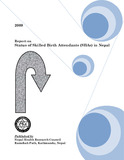Please use this identifier to cite or link to this item:
https://hdl.handle.net/20.500.14356/798Full metadata record
| DC Field | Value | Language |
|---|---|---|
| dc.contributor.author | Nepal Health Research Council (NHRC), Ramshah Path, Kathmandu, Nepal | |
| dc.date.accessioned | 2012-12-28T22:31:18Z | |
| dc.date.accessioned | 2022-11-08T10:20:54Z | - |
| dc.date.available | 2012-12-28T22:31:18Z | |
| dc.date.available | 2022-11-08T10:20:54Z | - |
| dc.date.issued | 2009 | |
| dc.identifier.uri | http://103.69.126.140:8080/handle/20.500.14356/798 | - |
| dc.description.abstract | Introduction: Nation has taken the steps to reduce the maternal and infant morbidity and mortality rate by implementing the policy of Skilled Birth Attendant (SBA) in Nepal. The high number of maternal death is due to poor awareness and obstetrics knowledge among general population which also includes traditional methods of delivery practices. In Nepal, mostly obstetric care is provided by poorly trained or untrained medical/health practitioners. In rural Nepal, most of the birth occurs at home without any assistance from trained mid-wives and general practitioners. These situations demonstrate the need of training to birth attendants, especially to reduce Maternal Mortality Rate (MMR) in the remote areas. About 80 percent of the population is living in rural areas and the existing health facilities are unable to meet the demand required by the program to reduce MMR and Neonatal Mortality Rate (NMR). The safety of mother and child is dependent upon the person’s skills who are attending/helping a mother during pregnancy, deliveries and postnatal period. So, training of skilled birth attendant is most to meet the Millennium Development Goal (MDG) 4 & 5. | en_US |
| dc.language.iso | en_US | en_US |
| dc.publisher | Nepal Health Research Council | en_US |
| dc.subject | Birth Attendants | en_US |
| dc.subject | Nepal | en_US |
| dc.title | Report on Status of Skilled Birth Attendants (SBAs) in Nepal | en_US |
| dc.type | Technical Report | en_US |
| Appears in Collections: | NHRC Research Report | |
Items in DSpace are protected by copyright, with all rights reserved, unless otherwise indicated.

